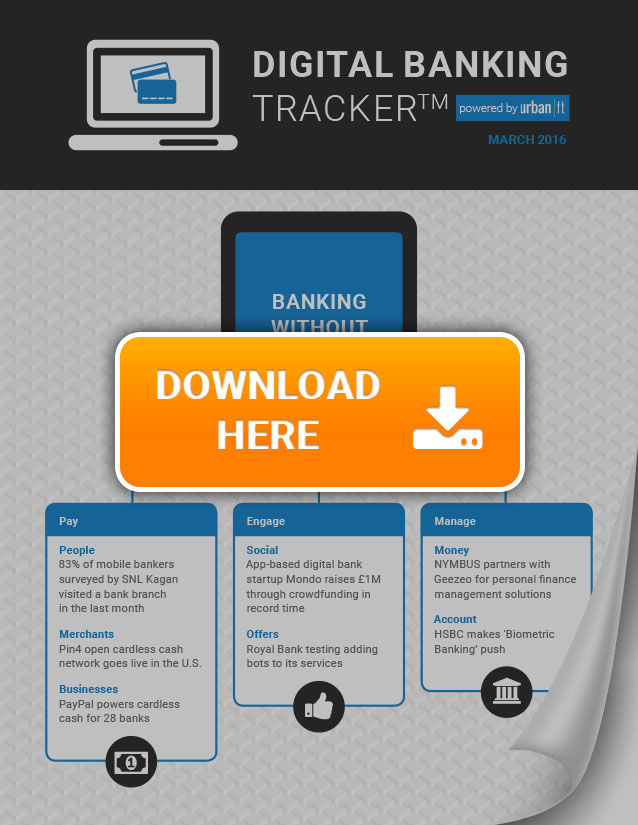A Challenge Wrapped In An Opportunity: Inside A Traditional Bank Embracing Digital

Just when one player seems to be pulling ahead, another comes up from behind. This month’s Digital Banking Tracker™ highlights the moves of 38 players (including 10 newcomers), as well as all the latest news that is shaking up the rapidly evolving space. Matthew Lehman, KeyBank’s SVP and head of online and mobile, weighs in on the digital banking evolution (and removes a click or two along the way). Catch that exclusive and so much more.
The challenges and opportunities for banks in the age of digital innovation are seemingly one and the same. Technological opportunities are themselves challenges that can set banks apart from the pack, either negatively or positively: They can keep them relevant and competitive, or the other way around. And with a staggering number of banking options out there, it’s increasingly difficult for financial institutions to differentiate themselves and for time-sapped consumers to choose what options best fit their needs. That’s why, in many ways, it’s easiest for consumers to stay with their tried-and-true banks – but if those banks intend to retain those clients for the long-haul they need to, in the least, keep up with their evolving needs.
How do traditional banks approach the challenge of adapting to the ever-evolving digital landscape and serving their customer needs? There obviously isn’t one perspective or strategy, but focusing on the customer first seems like as good a starting point as any.
PYMNTS recently caught up with Matthew Lehman, KeyBank’s SVP, Head of Online and Mobile, to discuss the evolution of digital banking and how a full-service bank is embracing digital and evolving along with its customers.
When it comes to bill payments, Lehman said, ease is a value he is focused on delivering to his bank’s customers. And they are finding ease in small increments – like removing clicks in individual payment transactions or enabling customers to add, modify and change payees through the bank’s mobile banking app, which are both examples of changes the bank has made and continues to refine.
“If we can make it easy and we remove that friction, it’s logical that a client would want to pay through a single source, rather than have to go to each of the biller sites individually and either set up those payments or make those payments on a one-off basis.”
Recently, Lehman said, KeyBank has been focused on offering a mobile full-service bill payment experience, similar to what’s available on the bank’s full online offering. The response, he said, has been extremely positive. “We’ve seen overall growth in the amount of bill payment activity,” he said. “And it very much fits with the standard use case of how many of our clients’ lives are changing today.” Time, he said, is a valuable commodity. Realizing that clients are on the move and enabling them to add payees quickly and make a payment, he said, “we’re trying to provide them time.”
Lehman mentioned that KeyBank does still offer a traditional rewards program, which, among other incentives does reward customers for making payments digitally. But, in order to remain relevant and be the go-to option for payments, Lehman said that Key’s primary means of encouraging client use of bill pay is by ensuring digital payments are easy to use and provide clients value by enabling them to make payments safely, securely and at their convenience. Fewer steps, as it turns out, is a reward in itself.
Discovering opportunity within data
Then there are the opportunities created from digital banking to use customer data to infuse further innovation into the experience. KeyBank, Lehman explained, builds on the basic benefits of digital payments by gaining insight into clients’ money management. For example, the bank is currently running a pilot program with HelloWallet, a personal finance guidance provider, which, Lehman said, “allows us to use that data to deliver meaningful insights about how you spend your money and, ideally, help you spend more wisely or, at a minimum, make you feel more confident about how you’re managing your financial life.”
The program, developed around financial wellness, uses data aggregated both from KeyBank data as well as other accounts, should participants opt to include them. Then, Lehman said, the goal is “to provide either recommendations or expertise for the client.” He said the bank has been pleased with the results of the program (although he declined to disclose details) and they plan to roll the program out wider as part of the bank’s overall digital offering in the near future.
Ensuring easy transactions are secure
A big part of any overall digital offering needs to be appropriate authentication and security measures. And, Lehman said, the more a bank can do to prevent fraudulent transactions from occurring, the better it is for the client and, of course, the financial institution itself. Ease of use is important, he said, “but also we want to have the appropriate security step-ups so that, should an individual’s account be illegally accessed, that we have some preventative measures to make sure that funds can’t be easily sent up.”
At KeyBank, he said, they use some step-up authentication and other measures to validate new payees. There’s also a good deal of behind-the-scenes activity that clients don’t see, he said. “We’re doing certain kinds of machine-based scoring to detect when a high-risk transaction is getting ready to take place,” he explained. The goal, he said, is the prevention of these transactions, rather than mopping up after they’ve occurred.
Digital adoption – no longer solely a millennial-focused play
Lehman said that KeyBank has experienced the embrace of digital banking, including mobile, as being an across-the-board adoption by its customers. Mobile itself, he said, was earlier on seen as more of a service for millennials, but now it’s mainstream. And, he said, the investment in mobile banking, along with the speed of customer adoption has been “very gratifying.”
The biggest challenge for the bank, Lehman said, is knowing where to focus. “The difficulty is always balancing the right investments to make sure that we’re placing the right bets. There’s no shortage of great ideas about how to make the experience better,” he said. “The biggest challenge has been and continues to be just making sure that we’re investing our shareholders’ money wisely and delivering the types of experiences that will be most impactful for our clients.”
Online and mobile bill pay is an area where Lehman sees a continued interest in development. “We’ll continue to look for ways to continue to grow the bill payment relationship, because it’s a very sticky one. Our clients that use bill pay have a very low attrition rate,” he said.
Differentiating from the disruptors
Continuing to push into the digital space, while not forgetting their roots as a full-service traditional bank, Lehman said, is essential to KeyBank’s future.
“While I fully expect more and more transactions will go digital, I think that [customers still need] a bank like Key that can deliver the full service on both sides of the transaction, offer multiple channels and particularly offer a level of expertise that may be delivered digitally through something like Financial Wellness or some of the products and services we’re building on the corporate side.”
At the end of the day, enabling customers via digital is essential, but digital needs to be seen as one of many ways that banks connect with clients. More importantly, Lehman said, is what happens when clients connect with banks — that is what will set banks apart from industry disruptors.
“Our focus on supporting financial wellness through client insight will redefine the client experience,” Lehman said. “Every contact we have with clients — whether a client connects with us via digital, by telephone or by stopping by a branch — will be based on what we know about that specific client. We want to do much more than help clients make transactions. We want to provide expertise that helps them make confident financial choices.’’
This high-tech, high-touch line of thinking means banks embracing both digital innovation and the tried-and-true approach of creating personal connections with clients may just be the formula for prevailing amidst the banking evolution.
To download the March edition of the PYMNTS Digital Banking TrackerTM, powered by Urban FT, click the button below.

